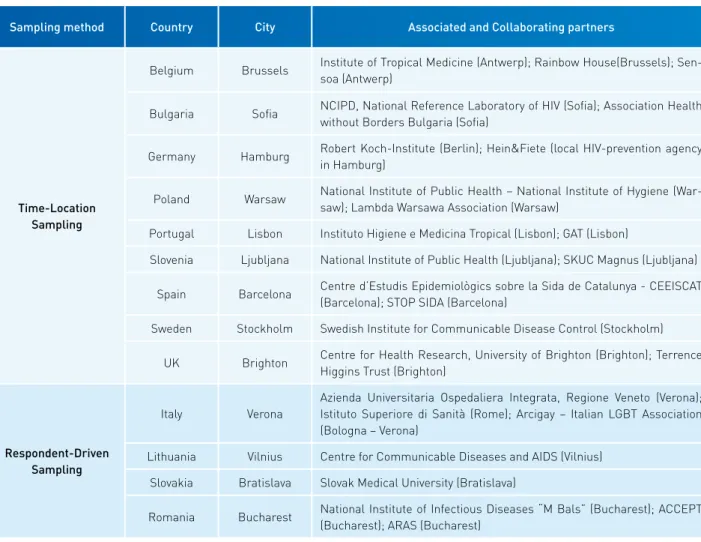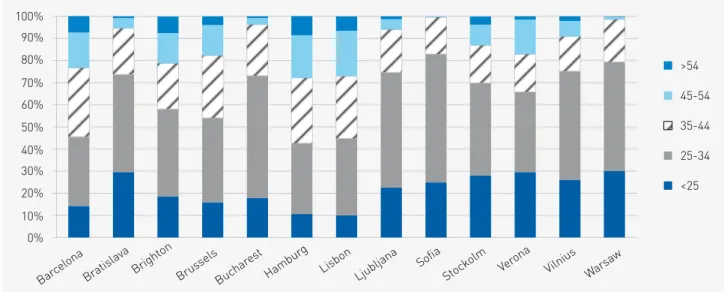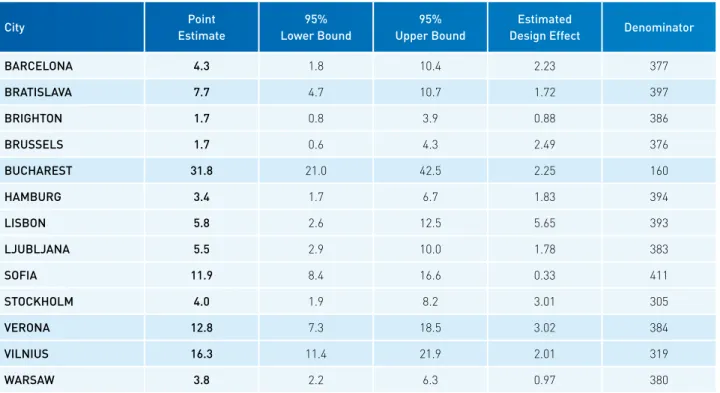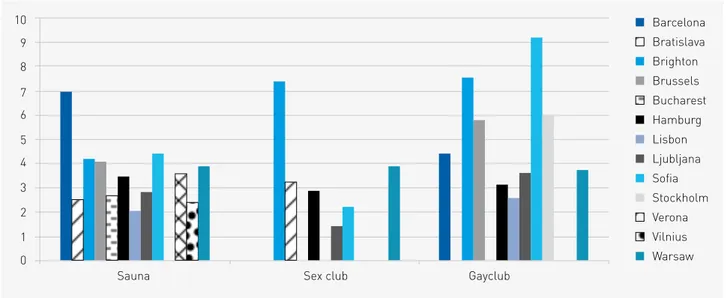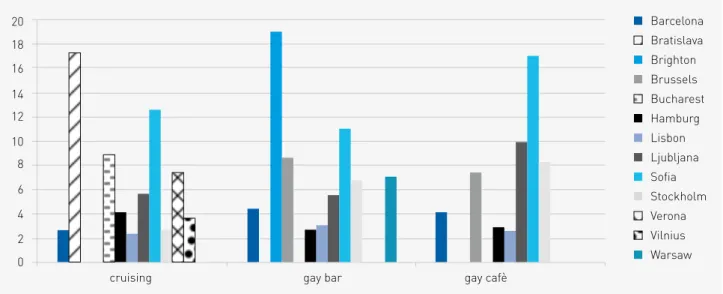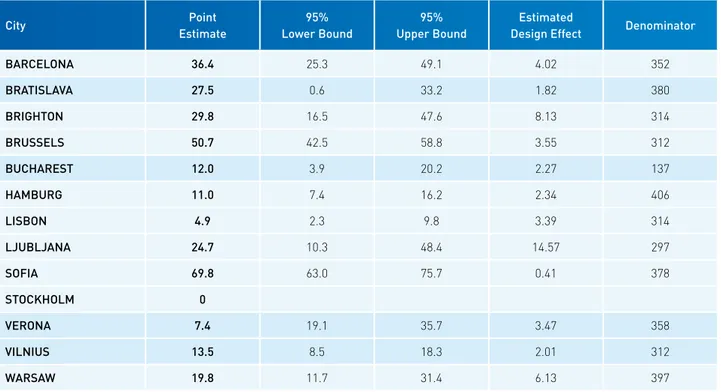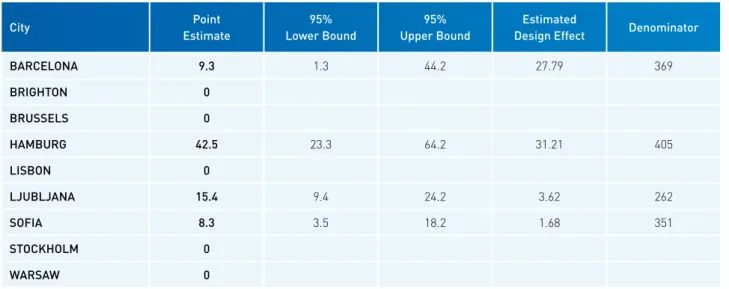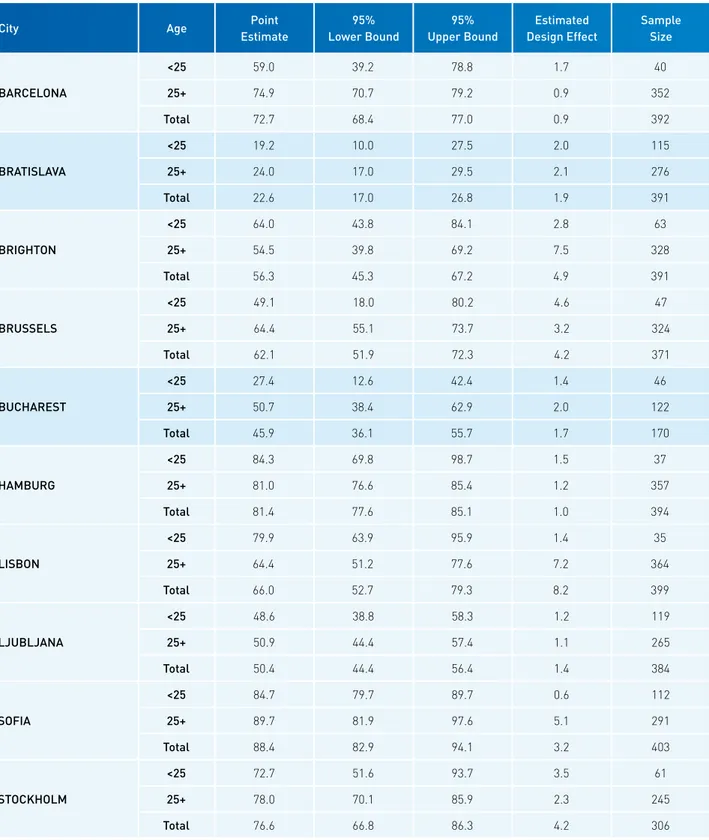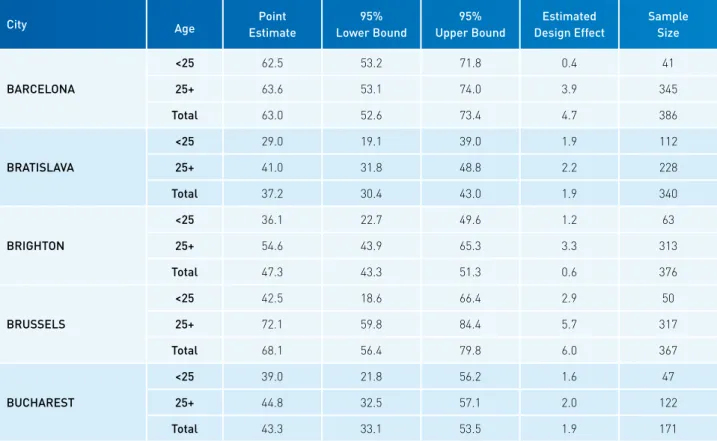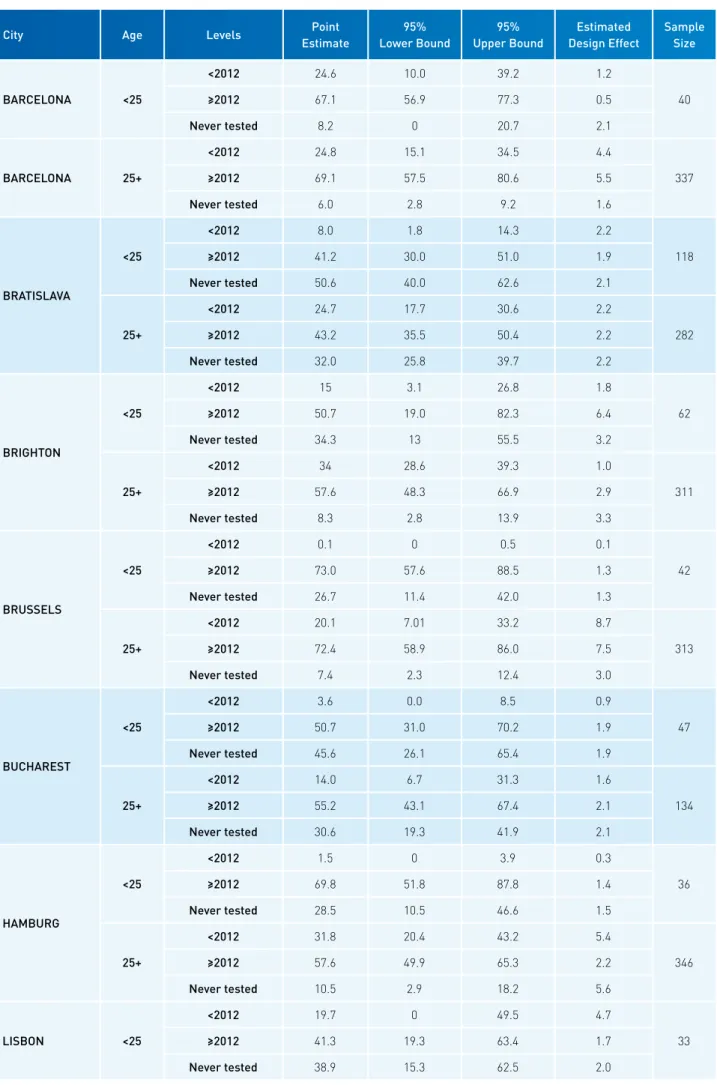Capacity building in combining targeted prevention
with meaningful HIV surveillance among MSM
RepoRt on a
Bio-BehaviouRal SuRvey
edit
or
s
massimo mirandola
Infectious Diseases Section, Department of Pathology-Verona Univer-sity Hospital - Veneto region & Coordinamento regionale per il Mana-gement e la Progettazione europea, azienda Ospedaliera Universitaria Integrata, Verona, Italy
lorenzo gios
Coordinamento regionale per il Management e la Progettazione euro-pea, azienda Ospedaliera Universitaria Integrata, Verona, Italy
nigel Sherriff
Centre for Health research CHr, University of Brighton, Brighton, UK
igor toskin
Department of reproductive Health & research World Health Organiza-tion, Geneva, Switzerland
marcus ulrich
robert Koch Institute, Berlin, Germany
Susanne Schink
robert Koch Institute, Berlin, Germany
Barbara Suligoi
Centro Operativo aIDS, Istituto Superiore di Sanità, rome, Italy
cinta Folch
Centre for epidemiological Studies on HIV/STI in Catalonia CeeISCaT, agència de Salut Pública de Catalunya, Barcelona, Spain
magdalena Rosińska
NIZP-PZH, Warsaw, Poland
Expert external reviewer
lisa Johnston
School of Public Health and Tropical Medicine, Tulane University, New Orleans, La, USa
Capacity building in combining targeted prevention with meaningful HIV surveillance among MSM
Report on a
Bio-behavioural Survey
among MSM
Co-funded by the Health Programme of the European Union
This document is based on data from the Sialon II project, co-funded under the European Commission’s (EC) Public Health Programme 2008-2013 (Work Plan 2010).
The sole responsibility lies with the authors of this report and the Commission is not responsible for any use that may be made of the information contained therein
Suggested citation for this report: The Sialon II Project. Report on a Bio-behavioural Survey among MSM in 13 European cities. ISBN 978-88-98768-55-4 Cierre Grafica, 2016. Editors: Massimo Mirandola, Lorenzo Gios, Nigel Sherriff, Igor Toskin, Ulrich Marcus, Susanne Schink, Barbara Suligoi, Cinta Folch, Magdalena Rosińska
Project Design: Ruggero Ughetti Print: Cierre Grafica | www.cierrenet.it © Cover picture by Juri Pozzi
1. Introduction ... 7 2. Background ... 21 3. Methods ... 29 4. Ethical considerations ... 43 5. Survey results ... 49 5.1 Sample description ... 53 5.2 Prevention programmes ... 73
5.3/5.4 Partner numbers, anal intercourse, and condom use with steady and non-steady partners in the last six months ... 87
5.5 Sexual behaviour in the last six months with a female partner ... 101
5.6 Sexual behaviour during last episode ... 109
5.7 Commercial sex ... 121
5.8 High risk sex behaviour (fisting) ... 127
5.9 HIV and other STIs ... 133
5.10 Treatment and viral load ... 147
5.11 Sexual health ... 159
5.12 Substance use ... 167
6. Discussion ... 181
7. Conclusions and recommendations ... 186
4 The Sialon II Project. Report on a Bio-behavioural Survey among MSM in 13 European cities
LISt of aBBrEvIatIonS
AI Anal intercourse
AIDS Acquired immune deficiency syndrome ARV Antiretroviral
CI Confidence interval DE Design Effect
EC European Commission
ECDC European Centre for Disease Prevention and Control EEA European Economic Area
EU European Union
GARPR Global AIDS Response Progress Reporting GUM Genito-urinary medicine
HBV Hepatitis B Virus HCV Hepatitis C Virus
HIV Human Immunodeficiency Virus LGV Lymphogranuloma venereum MS Member State
MSM Men who have Sex with Men NGO Non-Governmental Organization NSP Non-Steady Partner
OF Oral Fluids
PEP Post-Exposure Prophylaxis PIS Participant Information Sheet RDS Respondent-Driven Sampling
SGSS Second Generation Surveillance System SD Standard Deviation
SE Standard Error SP Steady Partner
STI Sexually Transmitted Infection TLS Time-Location Sampling UAI Unprotected Anal Intercourse UN United Nations
UNAIDS The Joint United Nations Programme on HIV/AIDS UNGASS United Nations General Assembly Special Session VCT Voluntary Counselling and Testing
VDT Venue-Day-Time
This report presents the findings from a large-scale bio-behavioural survey implemented across 13 Euro-pean countries. The survey was implemented in the context of the EuroEuro-pean Commission co-funded Sialon II project (see www.sialon.eu). The overall objective of the Sialon II project (2011-2014) was to carry out and pro-mote combined and targeted prevention, complemented by meaningful surveillance, among MSM. The Sialon II project follows on from its predecessor Sialon (2008-2010); both projects were set within a context of rising HIV infections among MSM in many countries across Europe as indicated by both the ECDC and the other scientific literature.
The Sialon II survey employed two different probability sampling procedures, namely Time-Location Sam-pling (TLS) and Respondent-Driven SamSam-pling (RDS). These two methods allowed researchers to enrol hetero-geneous populations and to collect reliable information on behaviour patterns, prevention needs and sexual health in the MSM population. The survey is without precedence in Europe in terms of its size and from the point of view of the practical implementation of the WHO – Joint United Nations Programme on HIV/AIDS (UNAIDS) Second Generation Surveillance System (SGSS) approach and behavioural surveillance recommendations from the ECDC.
The TLS method was adopted in Belgium, Bulgaria, Germany, Poland, Portugal, Slovenia, Spain, Sweden, and the UK whereas the RDS method was employed in Italy, Lithuania, Romania, and the Slovak Republic. The choice of sampling procedure was dependent both on the cultural and social characteristics of the participating cities and taking into consideration the activities of the previous Sialon project where only the TLS method was employed.
Data from the Sialon II survey have provided a wealth and diversity of insights regarding: access to preven-tion programs and testing in each partner country; results on sexual behaviour in the last six months (with steady and non-steady partners) including condom use; as well as findings relating to commercial sex, ‘fisting’, treatment and viral load, substance (mis)use, and sexual health (sexual satisfaction, sexual safety, and sexual autonomy). In terms of HIV prevalence, data suggested a range between 2% and 20%, with higher prevalence among individuals older than 25 years of age. A relevant proportion (ranging between 12% and 88%) of partici-pants were unaware of being HIV-positive.
On the one hand, the findings confirm the already identified trend of rising infection among MSM in Europe.
Ackno
wl
edgments
6 The Sialon II Project. Report on a Bio-behavioural Survey among MSM in 13 European cities
One the other hand, the data reveal some alarming findings with regard to prevention, treatment and support to MSM and underline the disparities within Europe.
The high number of MSM who were tested for the first time in the context of this survey, in particular in the Eastern European survey cities and the high estimates of HIV positive participants unaware of their real se-rum-status, seem to suggest critical conditions in terms of future increase of the HIV epidemic. The situation seems to be particularly concerning in Eastern European cities, where a low level of condom use is reported, as well as a high level of perceived discrimination.
The lack and/or delay in diagnosis is also a crucial factor in general. In several cities, the treatment coverage is less than optimal among individuals who know they are HIV positive indicating potential challenges in linkage to care and continuity of care.
This scenario reflects the marked diversity of the societal and political contexts of the countries involved, in particular with respect to the social and legal conditions for sexual minority emancipation. This will obviously have an impact on both surveillance and prevention activities and needs to be taken into consideration in the definition of policy in this area. This means that in addition to concrete measures such as increased condom distribution networks and promotion of testing and treatment, policy actions must also address the social de-terminants of high risk behaviour and low uptake of testing for HIV and other STIs such as homophobia and stigma.
Similarly, the segmentation and the complexity of the MSM population which this survey has contributed to identifying, point to the need to design targeted HIV prevention and health promotion interventions by sub-groups. For example, young MSM (<25 years) presented a particularly vulnerable subgroup of MSM engaging in high risk behaviour and experiencing a high perception of homonegativity. Another main subgroup identified in Sialon II are MSM attending venues from other European countries including migrants (non-native or non-res-ident MSM) and tourists, raising issues of increased vulnerability due to multiple marginalization in the case of migrants or limited access to prevention activities in the case of tourists.
To conclude, the findings of Sialon II survey represent a valid contribution to the pool of epidemiological research that has been has undertaken to date in the area of HIV/STI prevention among MSM. However, at the same time, the results also point to the urgent need for continued and more widespread data collection (in line with the SGGS) to better understand the marked differences in prevention needs across Europe and among sub-populations of MSM and hence to better define more effective and efficient prevention strategies.
Ackno
wl
edgments
First and foremost, the Sialon II team would like to thank all the anonymous survey respondents who provided us with their time to com-plete the survey and the venue owners who agreed to collaborate in the project. Without their contribution, the Sialon II project would not have been possible.
The project team is particularly grateful to the MSM community and civil society organisations, whose contribution was fundamental for project planning and implementation.
The Sialon II team would also like to acknowledge the colleagues from Associated and Collaborating Partners for the constant support, commitment and enthusiasm in the project implementation.
Special acknowledgment should also be given to:
• The Project Officer from the Executive Agency for Health and Con-sumers, Ms Cinthia Menel Lemos, and to the colleagues from DG SANTE, namely Mr Paolo Guglielmetti, Mr Wolfgang Philipp, Mr Matthias Schuppe, Mr Michael Hübel and Ms Velina Pendolovska. • The colleagues from the European Centre for Disease Prevention
and Control (ECDC) for the inputs provided during the overall project implementation. In particular, we would like to mention Mr Andrew Amato, Ms Irina Dinca, Ms Karin Haar, Ms Anastasia Pharris for their kindness and support and Mr Teymur Noori for his excellent sugges-tions and comments during the production of this report.
• The colleagues from the Department of Reproductive Health & Re-search of the World Health Organization (WHO) for their contribution in the planning phase of the project, as well as the support in the en-tire project implementation and monitoring stages, and in particular Mr Igor Toskin, Mr Armando Seuc and Ms Natalie Maurer.
• The colleagues from the Joint United Nations Programme on HIV/ AIDS (UNAIDS), who provided the project team with support and advice for the project planning and implementation. In particular, we would like to mention Mr Lev Zohrabyan, Ms Alexandrina Iovita and the colleagues from the “UNAIDS Scenarios for the Future of AIDS” team, Ms Maddalena Campioni and Mr Patrick Noack. •
Ms Rosanna Peeling from the London School of Hygiene and Tropi-cal Medicine, for her valuable contribution in the context of the Sia-lon II survey protocols for validation.
• The members of both the WHO Research Project Review Panel (RP2) and the Research Ethics Review Committee (WHO ERC), who reviewed the Sialon II project protocols, for their relevant inputs to the survey documents. Inputs received allowed to significantly im-prove the quality of the procedures protocols, guaranteeing a top level scientific and ethical quality.
• Ms Lisa Johnston for her support in the survey planning and imple-mentation, as well as for the valuable contributions in the review
Author
s and c
ontribut
or
s
Author
s and c
ontribut
or
s
Chapter 1, IntroductionMassimo Mirandola (Infectious Diseases Section, Department of Patho- logy-Verona University Hospital - Veneto Region & Coordinamento Re-gionale per il Management e la Progettazione Europea, Azienda Ospe-daliera Universitaria Integrata, Verona, Italy)
Lorenzo Gios (Coordinamento Regionale per il Management e la Pro-gettazione Europea, Azienda Ospedaliera Universitaria Integrata, Vero-na, Italy)
Nigel Sherriff (Centre for Health Research CHR, University of Brighton, Brighton, UK)
Chapter 2, Background
Lorenzo Gios (Coordinamento Regionale per il Management e la Pro-gettazione Europea, Azienda Ospedaliera Universitaria Integrata, Vero-na, Italy)
Massimo Mirandola (Infectious Diseases Section, Department of Patho- logy-Verona University Hospital - Veneto Region & Coordinamento Re-gionale per il Management e la Progettazione Europea, Azienda Ospe-daliera Universitaria Integrata, Verona, Italy)
Nigel Sherriff (Centre for Health Research CHR, University of Brighton, Brighton, UK)
Paolo Guglielmetti (European Commission, DG SANTE, Policy Officer responsible for Sialon II)
Cinthia Menel-Lemos (European Commission, CHAFEA, Project Officer responsible for Sialon II)
Chapter 3, Methods
Lorenzo Gios (Coordinamento Regionale per il Management e la Pro-gettazione Europea, Azienda Ospedaliera Universitaria Integrata, Vero-na, Italy)
Massimo Mirandola (Infectious Diseases Section, Department of Patho- logy-Verona University Hospital - Veneto Region & Coordinamento Re-gionale per il Management e la Progettazione Europea, Azienda Ospe-daliera Universitaria Integrata, Verona, Italy)
Lev Zohrabyan (Joint United Nations Programme on HIV/AIDS)
Igor Toskin (Department of Reproductive Health & Research World Health Organization, Geneva, Switzerland)
Nigel Sherriff (Centre for Health Research CHR, University of Brighton, Brighton, UK)
Author
s and c
ontribut
or
s
Wim Vanden Berghe (Institute of Tropical Medicine, ITG, Antwerp, Belgium) Christiana Nöstlinger (Institute of Tropical Medicine, ITG, Antwerp, Bel-gium)
Danica Staneková (Slovak Medical University, Bratislava, Slovakia) Lisa Johnston (School of Public Health and Tropical Medicine, Tulane University, New Orleans, LA, USA)
Sharon Kuhlmann-Berenzon (Public Health Agency of Sweden, Stock-holm, Sweden)
Inga Velicko (Public Health Agency of Sweden, Stockholm, Sweden) Cinta Folch (Centre for Epidemiological Studies on HIV/STI in Catalonia CEEISCAT, Agència de Salut Pública de Catalunya, Barcelona, Spain) Laia Ferrer (Centre for Epidemiological Studies on HIV/STI in Catalonia CEEISCAT, Agència de Salut Pública de Catalunya, Barcelona, Spain) Alexandra Montoliu (Centre for Epidemiological Studies on HIV/STI in Cata-lonia CEEISCAT, Agència de Salut Pública de Catalunya, Barcelona, Spain) Sónia Dias (Global Health and Tropical Medicine, GHTM, Instituto de Hi-giene e Medicina Tropical, IHMT, Universidade Nova de Lisboa, Portugal) Paolo Guglielmetti (European Commission, DG SANTE, Policy Officer responsible for Sialon II)
Cinthia Menel-Lemos (European Commission, CHAFEA, Project Officer responsible for Sialon II)
Chapter 4, Ethical considerations
Lorenzo Gios (Coordinamento Regionale per il Management e la Pro-gettazione Europea, Azienda Ospedaliera Universitaria Integrata, Vero-na, Italy)
Igor Toskin (Department of Reproductive Health & Research World Health Organization, Geneva, Switzerland)
Massimo Mirandola (Infectious Diseases Section, Department of Patho- logy-Verona University Hospital - Veneto Region & Coordinamento Re-gionale per il Management e la Progettazione Europea, Azienda Ospe-daliera Universitaria Integrata, Verona, Italy)
Nigel Sherriff (Centre for Health Research CHR, University of Brighton, Brighton, UK)
Paolo Guglielmetti (European Commission, DG SANTE, Policy Officer responsible for Sialon II)
Cinthia Menel-Lemos (European Commission, CHAFEA, Project Officer responsible for Sialon II)
Author
s and c
ontribut
or
s
Author
s and c
ontribut
or
s
Chapter 5, Survey results
Massimo Mirandola (Infectious Diseases Section, Department of Patho- logy-Verona University Hospital - Veneto Region & Coordinamento Re-gionale per il Management e la Progettazione Europea, Azienda Ospe-daliera Universitaria Integrata, Verona, Italy)
Lorenzo Gios (Coordinamento Regionale per il Management e la Pro-gettazione Europea, Azienda Ospedaliera Universitaria Integrata, Vero-na, Italy)
Nigel Sherriff (Centre for Health Research CHR, University of Brighton, Brighton, UK)
Section 5.1, Sample description
Cinta Folch (Centre for Epidemiological Studies on HIV/STI in Catalonia CEEISCAT, Agència de Salut Pública de Catalunya, Barcelona, Spain) Laia Ferrer (Centre for Epidemiological Studies on HIV/STI in Catalonia CEEISCAT, Agència de Salut Pública de Catalunya, Barcelona, Spain) Alexandra Montoliu (Centre for Epidemiological Studies on HIV/STI in Cata-lonia CEEISCAT, Agència de Salut Pública de Catalunya, Barcelona, Spain) Emilia Naseva (Medical University of Sofia, Faculty of Public Health; Program “Prevention and Control of HIV/AIDS”, Ministry of Health)
Section 5.2, Prevention programmes
Maria Axelsson (Public Health Agency of Sweden, Stockholm, Sweden) Torsten Berglund (Public Health Agency of Sweden, Stockholm, Sweden) Inga Velicko (Public Health Agency of Sweden, Stockholm, Sweden) Achilleas Tsoumanis (Public Health Agency of Sweden, Stockholm, Swe-den)
Sónia Dias (Global Health and Tropical Medicine, GHTM, Instituto de Hi-giene e Medicina Tropical, IHMT, Universidade Nova de Lisboa, Portugal) Massimo Mirandola (Infectious Diseases Section, Department of Patho- logy-Verona University Hospital - Veneto Region & Coordinamento Re-gionale per il Management e la Progettazione Europea, Azienda Ospe-daliera Universitaria Integrata, Verona, Italy)
Sharon Kuhlmann-Berenzon (Public Health Agency of Sweden, Stock-holm, Sweden)
Section 5.3 / 5.4 Partner numbers, anal intercourse, and condom use with steady and non-steady partners in the last six months
Author
s and c
ontribut
or
s
Susanne Schink (Robert Koch Institute, Berlin, Germany)
Nigel Sherriff (Centre for Health Research CHR, University of Brighton, Brighton, UK)
Section 5.5, Sexual behaviour in the last six months with a female partner
Nigel Sherriff (Centre for Health Research CHR, University of Brighton, Brighton, UK)
Lorenzo Gios (Coordinamento Regionale per il Management e la Pro-gettazione Europea, Azienda Ospedaliera Universitaria Integrata, Vero-na, Italy)
Massimo Mirandola (Infectious Diseases Section, Department of Patho- logy-Verona University Hospital - Veneto Region & Coordinamento Re-gionale per il Management e la Progettazione Europea, Azienda Ospe-daliera Universitaria Integrata, Verona, Italy)
Ulrich Marcus (Robert Koch Institute, Berlin, Germany) Susanne Schink (Robert Koch Institute, Berlin, Germany)
Section 5.6, Sexual behaviour during last episode
Ulrich Marcus (Robert Koch Institute, Berlin, Germany) Susanne Schink (Robert Koch Institute, Berlin, Germany)
Nigel Sherriff (Centre for Health Research CHR, University of Brighton, Brighton, UK)
Massimo Mirandola (Infectious Diseases Section, Department of Patho- logy-Verona University Hospital - Veneto Region & Coordinamento Re-gionale per il Management e la Progettazione Europea, Azienda Ospe-daliera Universitaria Integrata, Verona, Italy)
Lorenzo Gios (Coordinamento Regionale per il Management e la Pro-gettazione Europea, Azienda Ospedaliera Universitaria Integrata, Vero-na, Italy)
Section 5.7, Commercial sex
Michele Breveglieri (Coordinamento Regionale per il Management e la Progettazione Europea, Azienda Ospedaliera Universitaria Integrata, Verona, Italy)
Lorenzo Gios (Coordinamento Regionale per il Management e la Pro-gettazione Europea, Azienda Ospedaliera Universitaria Integrata, Vero-na, Italy)
Author
s and c
ontribut
or
s
Author
s and c
ontribut
or
s
gionale per il Management e la Progettazione Europea, Azienda Ospe-daliera Universitaria Integrata, Verona, Italy)
Section 5.8, High risk sex behaviour (fisting)
Danica Staneková (Slovak Medical University, Bratislava, Slovakia) Lorenzo Gios (Coordinamento Regionale per il Management e la Pro-gettazione Europea, Azienda Ospedaliera Universitaria Integrata, Vero-na, Italy)
Massimo Mirandola (Infectious Diseases Section, Department of Patho- logy-Verona University Hospital - Veneto Region & Coordinamento Re-gionale per il Management e la Progettazione Europea, Azienda Ospe-daliera Universitaria Integrata, Verona, Italy)
Nigel Sherriff (Centre for Health Research CHR, University of Brighton, Brighton, UK)
Section 5.9, HIV and other STIs
Barbara Suligoi (Centro Operativo AIDS, Istituto Superiore di Sanità, Rome, Italy)
Vincenza Regine (Centro Operativo AIDS, Istituto Superiore di Sanità, Rome, Italy)
Danica Staneková (Slovak Medical University, Bratislava, Slovakia) Massimo Mirandola (Infectious Diseases Section, Department of Pa-thology-Verona University Hospital - Veneto Region & Coordinamento Regionale per il Management e la Progettazione Europea, Azienda Os-pedaliera Universitaria Integrata, Verona, Italy)
Lorenzo Gios (Coordinamento Regionale per il Management e la Pro-gettazione Europea, Azienda Ospedaliera Universitaria Integrata, Vero-na, Italy)
Igor Toskin (Department of Reproductive Health & Research World Health Organization, Geneva, Switzerland)
Sharon Kuhlmann-Berenzon (Public Health Agency of Sweden, Stock-holm, Sweden)
Inga Velicko (Public Health Agency of Sweden, Stockholm, Sweden)
Section 5.10, Treatment and viral load
Magdalena Rosińska (National Institute of Public Health - National In-stitute of Hygiene, Warsaw, Poland)
Marta Niedźwiedzka-Stadnik (National Institute of Public Health - Na-tional Institute of Hygiene, Warsaw, Poland)
Author
s and c
ontribut
or
s
Ivailo Alexiev (National Center of Infectious and Parasitic Diseases, So-fia, Bulgaria)
Sónia Dias (Global Health and Tropical Medicine, GHTM, Instituto de Hi-giene e Medicina Tropical, IHMT, Universidade Nova de Lisboa, Portugal)
Section 5.11, Sexual health
Christiana Nöstlinger (Institute of Tropical Medicine, ITG, Antwerp, Bel-gium)
Wim Vanden Berghe (Institute of Tropical Medicine, ITG, Antwerp, Belgium) Igor Toskin (Department of Reproductive Health & Research World Health Organization, Geneva, Switzerland)
Cinta Folch (Centre for Epidemiological Studies on HIV/STI in Catalonia CEEISCAT, Agència de Salut Pública de Catalunya, Barcelona, Spain) Laia Ferrer (Centre for Epidemiological Studies on HIV/STI in Catalonia CEEISCAT, Agència de Salut Pública de Catalunya, Barcelona, Spain) Alexandra Montoliu (Centre for Epidemiological Studies on HIV/STI in Catalonia CEEISCAT, Agència de Salut Pública de Catalunya, Barcelona, Spain)
Alexandru Rafila (National Institute for infectious Diseases Prof. Dr. Matei Bals, University of Medicine and Pharmacy Carol Davila, Bucha-rest, Romania)
Daniela Pitigoi (National Institute for infectious Diseases Prof. Dr. Matei Bals, University of Medicine and Pharmacy Carol Davila, Bucharest, Ro-mania)
Adrian Abagiu (National Institute for infectious Diseases Prof. Dr. Matei Bals, Bucharest, Romania)
Carolina Marin (ACCEPT, Bucharest, Romania)
Saulius Caplinskas (Centre for Communicable Diseases and AIDS, Vil-nius, Lithuania)
Rima Krupenkaite (Centre for Communicable Diseases and AIDS, Vil-nius, Lithuania)
Ulrich Marcus (Robert Koch Institute, Berlin, Germany)
Nigel Sherriff (Centre for Health Research CHR, University of Brighton, Brighton, UK)
Section 5.12, Substance use
Magdalena Rosińska (National Institute of Public Health - National In-stitute of Hygiene, Warsaw, Poland)
Re
vie
w
er
s
Author
s and c
ontribut
or
s
Christiana Nöstlinger (Institute of Tropical Medicine, ITG, Antwerp, Bel-gium)
Cinta Folch (Centre for Epidemiological Studies on HIV/STI in Catalonia CEEISCAT, Agència de Salut Pública de Catalunya, Barcelona, Spain) Sónia Dias (Global Health and Tropical Medicine, GHTM, Instituto de Hi-giene e Medicina Tropical, IHMT, Universidade Nova de Lisboa, Portugal)
Chapter 6, Discussion
Massimo Mirandola (Infectious Diseases Section, Department of Pa-thology-Verona University Hospital - Veneto Region & Coordinamento Regionale per il Management e la Progettazione Europea, Azienda Os-pedaliera Universitaria Integrata, Verona, Italy)
Lorenzo Gios (Coordinamento Regionale per il Management e la Pro-gettazione Europea, Azienda Ospedaliera Universitaria Integrata, Vero-na, Italy)
Ruth Joanna Davis (Coordinamento Regionale per il Management e la Progettazione Europea, Azienda Ospedaliera Universitaria Integrata, Verona, Italy)
Nigel Sherriff (Centre for Health Research CHR, University of Brighton, Brighton, UK)
Paolo Guglielmetti (European Commission, DG SANTE, Policy Officer responsible for Sialon II)
Cinthia Menel-Lemos (European Commission, CHAFEA, Project Officer responsible for Sialon II)
Chapter 7, Conclusions and recommendations
Massimo Mirandola (Infectious Diseases Section, Department of Pa-thology-Verona University Hospital - Veneto Region & Coordinamento Regionale per il Management e la Progettazione Europea, Azienda Os-pedaliera Universitaria Integrata, Verona, Italy)
Lorenzo Gios (Coordinamento Regionale per il Management e la Pro-gettazione Europea, Azienda Ospedaliera Universitaria Integrata, Vero-na, Italy)
Ruth Joanna Davis (Coordinamento Regionale per il Management e la Progettazione Europea, Azienda Ospedaliera Universitaria Integrata, Verona, Italy)
Nigel Sherriff (Centre for Health Research CHR, University of Brighton, Brighton, UK)
Paolo Guglielmetti (European Commission, DG SANTE, Policy Officer responsible for Sialon II)
Cinthia Menel-Lemos (European Commission, CHAFEA, Project Officer responsible for Sialon II)
Re
vie
w
er
s
Teymur NooriEuropean Centre for Disease Prevention and Control, Stockholm, Sweden
Igor Toskin
Department of Reproductive Health & Research World Health Organiza-tion, Geneva, Switzerland
Lev Zohrabyan
Joint United Nations Programme on HIV/AIDS
Lisa Johnston
School of Public Health and Tropical Medicine, Tulane University, New Orleans, LA, USA
Massimo Mirandola
Infectious Diseases Section, Department of Pathology-Verona Univer- sity Hospital – Veneto Region & Coordinamento Regionale per il Man-agement e la Progettazione Europea, Azienda Ospedaliera Universitaria Integrata, Verona, Italy
Lorenzo Gios
Coordinamento Regionale per il Management e la Progettazione Euro-pea, Azienda Ospedaliera Universitaria Integrata, Verona, Italy
Cinta Folch Toda
Centre for Epidemiological Studies on HIV/STI in Catalonia CEEISCAT, Agència de Salut Pública de Catalunya, Barcelona, Spain
Susanne Schink
Robert Koch Institute, Berlin, Germany
Barbara Suligoi
Centro Operativo AIDS, Istituto Superiore di Sanità, Rome, Italy
Magdalena Rosińska
National Institute of Public Health - National Institute of Hygiene, War-saw, Poland
Ulrich Marcus
General introduction to the report
This document is a key deliverable of the European Sialon II project co-funded by the European Commission (see www.sialon.eu). It presents the main results of the Sialon II project and focuses specifically on the findings from a large-scale bio-behavioural survey implemented across 13 European countries.
In Chapter 2, the background to the Sialon II project is outlined including a summary of the relevant liter-ature and an overview of the current debates regarding the HIV/STI epidemic within Europe. In Chapter 3, the methodology of the Sialon II bio-behavioural survey is presented, summarising the main procedural and tech-nical issues involved. Ethical considerations relating to implementation from initial data collection to delivery of the test results and data analysis are then explored in Chapter 4.
The main results from the Sialon II survey are presented in Chapter 5 which includes a series of related sub-sections as follows: in Section 5.1, a detailed description of the sample including socio-demographic character-istics is provided. Data on access to prevention programmes and testing are explored in Section 5.2; Section 5.3 presents findings on sexual behaviour in the last six months with male non-steady partners, whereas Section 5.4 presents data on sexual behaviour in the last six months with male steady partners. Insights on sexual be-haviour with female partners are provided in Section 5.5. Data on sexual bebe-haviour during the last episode of sexual intercourse and on commercial sex are presented in Sections 5.6 and 5.7 respectively. Details on high risk behaviour (fisting) are reported in Section 5.8. Estimates on HIV and other STIs are provided in Section 5.9, whilst Section 5.10 focuses on treatment and viral load data. A comprehensive presentation of the project’s main results is completed by final sections on sexual health (5.11) and substance (mis)use (5.12).
In Chapter 6, the main findings and potential implications of the Sialon II data are discussed. Finally, in Chap-ter 7, the project’s key conclusions are presented followed by a series of recommendations for future action in the area of HIV/STI prevention.
Notes on the presentation of findings and other issues
During data analysis, the two different sampling methods used by the Sialon II survey (TLS and RDS) were
18 The Sialon II Project. Report on a Bio-behavioural Survey among MSM in 13 European cities
taken into account1. However, in order to provide the reader with clear and easy-to-read tables and graphs, data
are presented at city level independently from the actual sampling method used. In other words, data related to the cities are listed in alphabetical order (in both graphs and tables) without separating into TLS and RDS recruitment sites.
As final remark, this report is based on data from the Sialon II project, co-funded by CHAFEA under the 2008-2013 Second Health Programme (Work Plan 2010). The sole responsibility lies with the authors of this report, and the Commission is not responsible for any use that may be made of the information contained therein.
Massimo Mirandola, Lorenzo Gios, Nigel Sherriff
Authors
Lorenzo Gios
Coordinamento Regionale per il Management e la Progettazione Europea, Azienda Ospedaliera Universitaria Integrata, Verona, Italy
Massimo Mirandola
Infectious Diseases Section, Department of Pathology - Verona University Hospital - Veneto Region & Coordinamento Regionale per il Management e la Progettazione Europea,
Azienda Ospedaliera Universitaria Integrata, Verona, Italy
Nigel Sherriff
Centre for Health Research CHR, University of Brighton, Brighton, UK
Paolo Guglielmetti
European Commission, DG SANTE, Policy Officer responsible for Sialon II
Cinthia Menel-Lemos
European Commission, CHAFEA, Project Officer responsible for Sialon II
We would like to acknowledge the invaluable contribution of Teymur Noori of the ECDC for his excellent suggestions and comments during the production of this report
Summary
The HIV epidemic among MSM continues to represent a pressing public health issue in Europe. The need of structured surveillance initiatives where both biological (e.g. oral fluid) and behavioural data (e.g. from ques-tionnaires) are collected, is evident. The use of a common set of indicators adopted across Europe is also a key factor in monitoring the epidemic.
The Sialon II project, in line with the international literature (e.g. UNAIDS, WHO and ECDC reports and guidelines), includes the use of GARPR indicators and WHO-UNAIDS guidelines on testing in the framework of epidemiological studies. The project has contributed significantly to the harmonisation of surveillance methods across participating countries, delivering comparable data from behavioural and epidemiological indicators for MSM communities.
Introduction
This chapter provides an overview of the current situation with regard to MSM and HIV in Europe. In particu-lar, attention is drawn to some of the pressing issues relating to the monitoring of the epidemic and the urgent need for reliable and comparable data across European countries. Details of the first Sialon project are provided followed by a description of the subsequent SIALON II project including the survey objectives and an overview of the participating countries. In the final part of the chapter, a number of conclusions are highlighted relating to the contribution of the Sialon II research.
HIV and MSM in Europe
The HIV epidemic continues to represent a critical public health issue in Europe and elsewhere (ECDC/WHO, 2013). Data and documents from the ECDC show that for the WHO European Region, 136.235 new HIV diagnoses
22 The Sialon II Project. Report on a Bio-behavioural Survey among MSM in 13 European cities
were reported in 2014, with a rate of 15.7 per 100.000. Therefore, the cumulative number of infections diagnosed in the WHO European Region increased to a total of 1,715,434.
With regard to the mode of transmission in the EU/EEA countries in 2013, the highest proportion of new HIV diagnoses was reported in men who have sex with men (MSM) accounting for 42% of all new infections (com-pared to 40.4% in 2012) (ECDC / WHO, 2014).
Mode of transmission of newly-diagnosed HIV cases reported in the EU/EEA 2013 (ECDC / WHO, 2013)
Number of new HIV diagnoses among MSM EU/EEA 2004-2013 (ECDCl / WHO, 2013)
0 1000 2000 3000 4000 5000 6000 7000 8000 9000 10000 2004 2005 2006 2007 2008 2009 2010 2011 2012 2013 N um be r of r ep or te d ca se s Year of diagnosis +33%
In EU/EEA countries where data are available, since 2004 HIV diagnoses have increased by 33% among MSM, confirming that this specific sub-population continues to represent a majority of the new HIV infected people across Europe. Consequently, this sub-population is considered as a population at high risk for acquiring HIV.
Moreover, according to the most recent data available from the ECDC (2015), HIV prevalence among MSM appears to be 5% or above in more than half of all EU/EEA countries. According to the Global AIDS Response
Heterosexual
(excluding cases from generalised epidemic countries) Heterosexual
(from generalised epidemic countries) Sex between men
Injecting drug use
Mother-to-child transmission Unknown 21% 11% 42% 5% 20% 1% n = 29 157
Progress Reporting (GARPR) disaggregation, reported prevalence is lower for MSM under 25 years old (roughly 2.9%) than for MSM over 25 years old (roughly 7.7%) (ECDC, 2015). In general, new diagnoses have increased dramatically in younger MSM in the EU/EEA area: between 2004 and 2013, the number of new HIV-positive MSM aged 20-24yrs almost doubled, whereas in adult MSM (30-39 years old) the estimates remain relatively stable.
Whilst these levels of new diagnoses and HIV prevalence could be due to increasing HIV testing, it is also likely that new diagnoses in the younger age groups represent ongoing transmission in this specific population. Indeed, with regard to the latter, according to the current scientific literature an increase of high risk sexual practices (such as unprotected anal intercourse) has been reported among MSM across Europe (ECDC / WHO, 2014; ECDC, 2012). Almost one third of all HIV infected MSM in Europe are estimated to be unaware of their seropositive status.
Monitoring the epidemic: GARPR indicators
HIV diagnosis represents a key surveillance activity for monitoring the HIV epidemic especially in ‘hard-to-reach’ populations such as MSM. Reliable and comparable data, including trends in risk behaviours over time, are of crucial importance in order to monitor the outbreak of infections, and to understand whether and by how much rates are increasing and which populations (or sub-populations) are affected the most.
Consequently, the international literature has stressed the need for public health to embrace three main ap-proaches in monitoring and controlling the epidemic: (i) a structured surveillance system method, the so-called Second Generation Surveillance System; (ii) the use a of common set of indicators adopted across Europe, and; (iii) specific prevention campaigns targeting MSM and testing promotion.
In terms of structured surveillance initiatives and in response to the growing awareness of the urgency for a comprehensive and effective response, a number of European countries have implemented surveys specifically targeting MSM (Elford, 2009) focusing primarily on the monitoring of risk behaviours. A SGSS approach (UN-AIDS, 2002), where both biological (e.g. oral fluid) and behavioural data (e.g. from questionnaires) are collected and triangulated, has unfortunately only been adopted in a limited number of studies (Dubois-Arber, 2010). This represents a challenging issue and limits the value of such targeted initiatives due to, amongst others, a lack of comparability of data across European countries (UNAIDS Joint United Nations Programme on HIV/AIDS and WHO, 2000). A SGSS approach is defined by the WHO as the “regular, systematic collection, analysis and interpretation of information for use in tracking and describing changes in the HIV/AIDS epidemic over time”. This approach is central not only because it allows the public health sector to monitor the spread of infections in a given population and to analyse trends over time, but also as it can facilitate countries in improving their planning of prevention initiatives.
With regard to the use of common indicators across Europe to monitor and control the epidemic, imple-mentation is not systematic. Often considerable variations across countries are reported both in terms of the specific indicators used and the way in which such indicators are calculated and used for reporting. Conse-quently, the implementation of harmonised HIV-STI surveillance systems across Europe could be a crucial tool in monitoring the HIV epidemic effectively in high-risk populations including MSM (Elford J, 2009).
In 2001 the United Nations General Assembly, in a Special Session on HIV/AIDS, proposed the construction of a set of core indicators, namely the UNGASS indicators to boost the harmonisation of data at the international level (UNAIDS, 2008; WHO/UNAIDS, 2009). These UNGASS indicators have been revised and updated periodi-cally, becoming in 2012 “the Global AIDS Response Progress Reporting (GARPR) indicators”. The most recent version of the indicators guidelines were released in 2014 by UNAIDS, UNICEF and the WHO (UNAIDS, 2014). Through the framework of monitoring the Dublin Declaration in Europe and Central Asia, ECDC and WHO have harmonised its indicators on HIV testing, condom use and HIV prevalence among MSM (UNAIDS/WHO working group on global HIV/AIDS and STI surveillance, 2011).
GARPR indicators represent a unique tool that can assist countries in evaluating the effectiveness of their HIV-STIs programmes, providing policy makers, scientific communities, civil societies and other stakeholders
24 The Sialon II Project. Report on a Bio-behavioural Survey among MSM in 13 European cities
with clear and direct markers on the status of the epidemic across different target-groups. Moreover, when GARPR data are collected and investigated across several countries, such indicators can provide crucial in-sights from a regional perspective, also providing a general overview of prevention needs or areas where the implementation of specific actions or campaigns is urgently needed.
The first Sialon project (2008-2010)
The first Sialon project (Sialon: Capacity building in HIV/Syphilis prevalence estimation using non-invasive methods among MSM in Southern and Eastern Europe) was funded under the 2003-2008 Public Health Pro-gramme (work plan 2007) (Mirandola, 2009). The project was designed to obtain reliable and valid data on HIV and Syphilis prevalence, as well as explore associated risk behaviours including cultural factors among MSM. Non-invasive outreach testing was used based on oral fluid sample collections and an anonymous question-naire was administered for collecting behavioural data. Time-Location Sampling (TLS) was adopted with the active involvement of gay associations in each data collection site. The study was a descriptive multi-centre biological and behavioural cross-sectional survey carried out in seven Southern and Eastern European cities including: Athens (Greece); Barcelona (Spain); Bratislava (Slovakia); Bucharest (Romania); Ljubljana (Slove-nia), Prague (Czech Republic); and Verona (Italy). International core indicators (called UNGASS indicators at that time, now GARPR indicators) were utilised in order to collect reliable and comparable data across partic-ipating countries.
The Sialon results (Mirandola, 2009) highlighted primarily the need for health promotion and prevention messages to be focused particularly on sexual behaviour, as well as raising the importance of testing promotion especially among young MSM, and highlighting the urgency of collecting additional and reliable information for STIs other than HIV. Data generated through the first Sialon project were used not only to monitor the respective HIV epidemics in partner countries, but also to harmonise the data collection process across the participating countries. In doing so, the study’s protocols proved to be an effective tool in planning and implementing large scale bio-behavioural surveys. As a result, a second Sialon II project was developed and submitted for funding to the EC’s 2008-2013 Public Health Programme.
The Sialon II project
Building on the successes and experiences of the first Sialon project (Mirandola, 2009), and in line with the 2009-2013 European Commission (EC) Communication on combating HIV/AIDS in the European Union (EU) and neighbouring countries (EC, 2009) and with the operational Action Plan which has recently been updated to cover the period 2014-2016 (EC, 2014), the overall objective of the Sialon II project was to carry out and promote combined and targeted prevention, complemented by meaningful surveillance, among MSM.
More specifically, the aim was to build capacity, knowledge, and expertise across the participating countries in terms of delivering effective prevention actions and of implementing innovative surveillance methodologies for MSM.
Sialon II was funded under the EC Public Health Programme 2008-2013 (Work Plan 2010). The project’s strate-gic relevance was threefold: i) Sialon II collected behavioural and biolostrate-gical data as well as assessed the preven-tion needs of MSM in line with the WHO and UNAIDS’ recommendapreven-tions on SGSS; ii) the project addressed directly the need for effective responses in priority regions such as the EU Member States most affected by HIV; and iii) complementing the EC’s 2010 Health Programme, Sialon II targeted MSM specifically as a (sub) population at high risk of acquiring HIV and other STIs.
Sialon II worked in active collaboration with diverse gay communities in all phases of the project actions. As examples, this included members of gay communities as project partners, as key collaborators, and as key informers in developing and implementing targeted and culturally sensitive strategies of communication for the
prevention of HIV and promotion of Voluntary Counselling and Testing (VCT) among MSM. Sialon II also worked in partnership with other major stakeholders including the ECDC, the WHO and UNAIDS, particularly during the initial development phase of the project. Such collaborations contributed considerably to the development and successful application of standard methodologies across the partner countries (including the research proto-cols, core GARPR/ECDC indicators, and epidemiological algorithms) as well as refining the specific prevention strategies to be implemented. Finally, further to collaborations with European institutions and countries, new partnerships were also established with EU neighbouring countries including Armenia and Moldova with the support of the WHO and UNAIDS.
Sialon II survey objectives
The Sialon II survey had the following primary objectives:
• To pilot the implementation of a bio-behavioural survey using different sampling methods, namely Time-Lo-cation Sampling (TLS) and Respondent-Driven Sampling (RDS);
• To estimate anti-HIV-Ab prevalence among MSM in data collection using the TLS method;
• To estimate anti-HIV-Ab, Syphilis, HBV-HVC prevalence among MSM in data collection sites using the RDS method;
• To identify, describe and analyse sexual risk behaviour patterns, prevention needs and sexual health in the MSM population, triangulating the behavioural data (risk behaviours, socio-ecological or contextual fac-tors) and the biological information.
As noted earlier, these survey objectives were consistent with the SGSS approach and with the ECDC and WHO behavioural surveillance recommendations (UNAIDS/WHO working group on global HIV/AIDS and STI sur-veillance, 2011). The main GARPR indicators related to MSM which were included in the Sialon II surveys were as follows:
• Indicator 1.11: Men who have sex with men: prevention programmes (percentage of men who have sex with men reached with HIV prevention programmes);
• Indicator 1.12: Men who have sex with men: condom use (percentage of men reporting the use of a condom the last time they had anal sex with a male partner);
• Indicator 1.13: HIV testing in men who have sex with men (percentage of men who have sex with men who received an HIV test in the past 12 months and know their results);
• Indicator 1.14: HIV prevalence in men who have sex with men (percentage of men who have sex with men risk who are living with HIV).
In terms of behaviours, the broader scientific literature as well as WHO-UNAIDS specific publications, stress the importance of monitoring key behaviours and attitudes connected to the transmission of HIV and STIs, namely:
• Sexual behaviour (condom use, sexual practices, number and type of sexual partners); • Substance use/abuse;
• Health seeking behaviours (access to VCT);
• STI indicators (self-reported past history of STI testing/STI (all sites), and biomarkers).
In addition, given that behaviours are strongly influenced by characteristics of the socio-ecological environ-ment (e.g. such as public policy on HIV, different types of social venues targeting MSM such as discos, bars, clubs, saunas etc. as well as access to, and quality of, local health and care services) (Dahlgren, 1991), Sialon II also considered how knowledge about such characteristics might be useful in improving sexual health and prevention activities and programmes for MSM.
26 The Sialon II Project. Report on a Bio-behavioural Survey among MSM in 13 European cities
Overview of the Sialon II survey countries
In Sialon II, a total of 13 countries were involved in implementing the bio-behavioural survey including Swe-den, United Kingdom, Belgium, Germany, Portugal, Spain, Italy, Bulgaria, Lithuania, Poland, Romania, Slovak Republic and Slovenia. Such diverse geographical coverage inevitably meant the existence of very different cultural and social contexts and thus the choice of methodology to be implemented, namely TLS (Belgium, Bul-garia, Germany, Poland, Portugal, Slovenia, Spain, Sweden, and the UK) or RDS (Italy, Lithuania, Romania, and the Slovak Republic) was dependent on the characteristics of the particular city in question.
Conclusions
Increases in HIV cases among MSM continue to be reported by the ECDC and in the wider international sci-entific literature. Effective interventions to monitor and control HIV epidemics among this specific target group remain a priority. In this process, it is imperative to gain reliable and comparable data on epidemic patterns within and between countries, as well as meaningful assessment, identification, and response to MSM preven-tion needs.
The Sialon II project has contributed significantly to the harmonisation of surveillance methods across par-ticipating countries and in doing so, has increased directly the public health response at country and European level. The comparable data on behavioural and epidemiological indicators for MSM communities (ECDC and GARPR indicators) presented in this report can be used at local, European, and international levels.
Through initial formative research, the project has identified unmet prevention needs and built communi-ty-based capacity to carry out research and prevention in venue-based settings. While the Sialon II prevention campaign was designed to take place in the context of the TLS and RDS data collection venues, implemen-tation of prevention activities went beyond the data collection as such. Sialon II adopted a community-based, participatory approach throughout the whole project, which contributed to identify the shortcomings of existing prevention policies and measures, and strengthened a Europe-wide network of international (UNAIDS, WHO) and European institutions (European Commission, ECDC), National Institutes of Public Health, Universities, and civil society organisations (NGOs working with and for MSM).
References
(n.d.). Retrieved from http://www.who.int/hiv/topics/surveillance/2ndgen/en/
Dahlgren, W. (1991). Policies and strategies to promote social equity in health. Stockholm: Institute for Fu-ture Studies.
Dubois-Arber, F. (2010). Mapping HIV/STI behavioural surveillance in Europe. BMC Infectious Diseases, 10:290.
ECDC (2015). ECDC SPECIAL REPORT. Thematic report: Men who have sex with men. Monitoring implemen-tation of the Dublin Declaration on Partnership to Fight HIV/AIDS in Europe and Central Asia: 2014 progress report. Stockholm: European Centre for Disease Prevention and Control.
ECDC / WHO. (2014). HIV/AIDS surveillance in Europe 2013. Stockholm: European Centre for Disease Pre-vention and Control.
ECDC / WHO. (2013). HIV/AIDS surveillance in Europe 2012. Stockholm: European Centre for Disease Pre-vention and Control.
ECDC (2012). Evidence Brief. Men who have Sex with Men. Monitoring implementation of the Dublin Decla-ration on Partnership to Fight HIV/AIDS in Europe and Central Asia: 2012 progress report. Stockholm: European Centre for Disease Prevention and Control.
EC (2009). Communication From The Commission To The European Parliament, The Council, The European Economic And Social Committee And The Committee Of The Regions. Combating HIV/AIDS in the European Union and neighbouring countries, 2009-2013.
EC (2014). Commission Staff Working Document. Action Plan on HIV/AIDS in the EU and neighbouring coun-tries: 2014-2016. http://ec.europa.eu/health/sti_prevention/docs/ec_hiv_actionplan_2014_en.pdf European Commission.
Elford, J. et al. (2009). HIV and STI behavioural surveillance among men who have sex with men in Europe. 14(47):pii=19414.
Mirandola, M. et al. (2009). HIV bio-behavioural survey among men who have sex with men in Barcelona, Bratislava, Bucharest, Ljubljana, Prague and Verona, 2008-2009. Euro Surveillance, 14(48):pii=19427.
UNAIDS Joint United Nations Programme on HIV/AIDS and WHO (2000). Guidelines for second generation surveillance. Geneva: World Health Organization.
UNAIDS / WHO working group on global HIV/AIDS and STI surveillance (2011). Guidelines on surveillance among populations most at risk for HIV UNAIDS/WHO working group on global HIV/AIDS and STI surveillance. WHO. Geneva: World Health Organization.
UNAIDS (2008). Monitoring the Declaration of Commitment on HIVAIDS. Guidelines on construction of core indicators – 2008 Reporting UNGASS. Geneva: Joint United Nations Programme on HIV/AIDS (UNAIDS).
UNAIDS (2014). Global AIDS response progress reporting 2014: construction of core indicators for moni-toring the 2011 UN political declaration on HIV/AIDS. Geneva: Joint United Nations Programme on HIV/AIDS (UNAIDS), WHO Library Cataloguing-in-Publication Data.
UNAIDS/WHO (2002). Initiating Second Generation HIV Surveillance Systems: Practical Guidelines. Joint United Nations Programme on HIV/AIDS (UNAIDS).
WHO/UNAIDS (2009). Monitoring the Declaration of Commitment on HIV/AIDS: guidelines on construction of core indicators: 2010 reporting. Geneva: Joint United Nations Programme on HIV/AIDS (UNAIDS).
Authors
Lorenzo Gios
Coordinamento Regionale per il Management e la Progettazione Europea, Azienda Ospedaliera Universitaria Integrata, Verona, Italy
Massimo Mirandola
Infectious Diseases Section, Department of Pathology - Verona University Hospital - Veneto Region & Coordinamento Regionale per il Management e la Progettazione Europea,
Azienda Ospedaliera Universitaria Integrata, Verona, Italy
Lev Zohrabyan
Joint United Nations Programme on HIV/AIDS
Igor Toskin
Department of Reproductive Health & Research World Health Organization, Geneva, Switzerland
nigel Sherriff
Centre for Health Research CHR, University of Brighton, Brighton, UK
Ulrich Marcus
Robert Koch Institute, Berlin, Germany
Wim Vanden Berghe
Institute of Tropical Medicine, ITG, Antwerp, Belgium
Christiana Nöstlinger
Institute of Tropical Medicine, ITG, Antwerp, Belgium
Danica Staneková
Slovak Medical University, Bratislava, Slovakia
Lisa Johnston
Lisa Johnston, School of Public Health and Tropical Medicine, Tulane University, New Orleans, LA, USA
Sharon Kuhlmann-Berenzon
Public Health Agency of Sweden, Stockholm, Sweden
Inga Velicko
Public Health Agency of Sweden, Stockholm, Sweden
Cinta Folch
Centre for Epidemiological Studies on HIV/STI in Catalonia CEEISCAT, Agència de Salut Pública de Catalunya, Barcelona, Spain
Laia Ferrer
Centre for Epidemiological Studies on HIV/STI in Catalonia CEEISCAT, Agència de Salut Pública de Catalunya, Barcelona, Spain
Alexandra Montoliu
Centre for Epidemiological Studies on HIV/STI in Catalonia CEEISCAT, Agència de Salut Pública de Catalunya, Barcelona, Spain
Sónia Dias
Global Health and Tropical Medicine, GHTM, Instituto de Higiene e Medicina Tropical, IHMT, Universidade Nova de Lisboa, Portugal
Paolo Guglielmetti
European Commission, DG SANTE, Policy Officer responsible for Sialon II
Cinthia Menel-Lemos
European Commission, CHAFEA, Project Officer responsible for Sialon II
We would like to acknowledge the invaluable contribution of Teymur Noori of the ECDC for his excellent suggestions and comments during the production of this report
Summary
Two different probability sampling procedures were used to sample MSM for the Sialon II survey: Time-Loca-tion Sampling (TLS) and Respondent-Driven Sampling (RDS). The first procedure is based on venues where the target population congregates, whilst the second is based on a peer-to-peer recruitment process. Preliminary formative research was carried out as well as dedicated training for data collectors and lab staff. A question-naire for collecting behavioural data was developed in line with the international indicators (ECDC, GARPR) and lab procedures were identified according to both local standards and WHO guidelines. Finally, specific sampling weights procedures were followed in line with the two methods adopted.
Introduction
In this Chapter, details of the sampling methods and procedures are provided for the Sialon II study. Spe-cifically, a general introduction to TLS and RDS methods is presented including a brief consideration of their advantages and disadvantages. This chapter provides Information about formative research, the data collection locations, including selection of recruitment sites, and the study design, including the sample size, inclusion/ exclusion criteria, tool development and implementation procedures. A description of the behavioural ques-tionnaire and laboratory procedures conducted for the biological component of the survey are also presented. The Chapter ends with a detailed consideration of the data management and analytical procedures adopted, including the weighting systems.
Introduction to TLS and RDS methods
Two different probability sampling methods were used to sample MSM for the Sialon II survey: Time-Lo-cation Sampling (TLS) (Williamson, 2007; Stueve, 2001) and Respondent-Driven Sampling (RDS) (Heckathorn,
30 The Sialon II Project. Report on a Bio-behavioural Survey among MSM in 13 European cities
1997). According to the literature, these methods are considered effective in gathering representative samples of populations that are considered hard to reach or hidden (Montealegre, 2013; Malekinejad, 2008).
TLS approximates random cluster sampling whereby everyone attending the cluster (or venue) has an equal chance of inclusion but are sampled as a group. The basis for TLS is to construct a ‘universe of venues’ where the target population congregates and to select randomly the venue, day of the week, and time of day (venue-day-time [VDT] units) from this universe. Eligible persons from these units are then sampled randomly. Fol-lowing data collection, data are analysed to adjust for any cluster effects. A complete venue universe serves as the sampling frame and is essential for TLS being considered (at least theoretically) as a probability sampling method. The venue universe is also a useful tool for understanding the geography and diversity of the target population.
Respondent Driven Sampling (RDS) is a chain-referral sampling method that incorporates numerous the-oretical and analytical assumptions to provide representative estimates of the network of the population sam-pled. RDS recruitment begins with a set number of individuals or ’seeds’, selected purposefully from the target population. Seeds are trained to recruit a set number of individuals from their social network of peers. The recruits of the seeds who enrol in an RDS survey are also trained to recruit a set number of individuals from their social network of peers. Seeds and recruited participants typically receive incentives in return for their participation (referred to as primary incentives) and for referring additional recruits (secondary incentives). Ideally, this process results in long recruitment chains made up of several ’waves’ of recruits. As recruitment chains lengthen, the composition of the sample becomes less dependent on the purposefully selected seeds and the sample becomes increasingly similar to the population being sampled. RDS also involves a complex analytical component crucial for generating population estimates and confidence intervals using data collected about each participant’s social network size and recruitment patterns.
Pros and cons of TLS and RDS methods
TLS is useful for recruiting MSM who attend different types of gay venues in a given city. The formative research stage of TLS is particularly important in the recruitment process as it allows the identification of all venues (locations) at which enough persons from the population of interest could be found on some day during a period of at least 4 hours to make recruitment feasible (Karon, 2012). However, TLS misses members of the tar-get population (in this case MSM) who never or rarely attend venues. Therefore, estimates from TLS represent only ‘visible’ MSM, that is, MSM who are attending the gay scene (the venues that were selected through the formative research in each study site). TLS is prone to systematic bias when a complete and accurate universe of the venues cannot be created. This may be because sites change between the mapping and study initiation period (e.g. venues closing down or new ones opening), venue owners do not allow access, or venues are too hidden or dangerous to map. Implementing TLS requires resources to perform a comprehensive mapping of all venues as well as keeping accurate and thorough records of the enumeration and mapping process, and to conduct data collection at often unsociable hours.
RDS is one of the most widely used methods to sample the most hidden and hard to reach populations world-wide, including those who are not visible at venues (Montealegre, 2013). However, if the population of interest is not socially networked, other sampling methods should be considered. Compared to TLS, RDS is better suited for allowing researchers to collect blood and serum samples for testing because participants must enrol in the study at a fixed site. Having a fixed site also allows for the delivery of counselling and test results and fewer distractions for participants completing self-administered questionnaires. RDS is also useful for providing opportunities to de-liver health promotion or HIV prevention interventions to participants (Latkin, 1999). As RDS relies on participants to recruit their peers, research staff are not required to engage with potential participants, thereby conceivably increasing accessibility to the study. Nevertheless, like TLS, RDS requires rigorous management by trained staff to collect data on who recruited whom and to measure each participant’s social network size, both of which are essential to conducting data analysis. Some studies comparing RDS and TLS samples (Kendall, 2008; Zhao, 2014)
have shown that each method is prone to sample MSM from dissimilar segments of the population. For instance, RDS has been known to over-represent MSM subgroups that are younger and are from lower SES group (Sabin, 2014) and in the case of the SAILON II study, MSM sampled with RDS in Bucharest comprised a network of MSM who injected drugs and sold sex. This can result in different sample characteristics, and the differences may persist also after these data are weighted. It is, therefore, important to understand the underlying network struc-ture of the population to clearly define the final denominator in the sample. As RDS is a network based sampling method, analysis is particularly complex and requires the use of open source software such as RDSAT (www. respondentdrivensampling.org) or RDS Analyst (www.hpmrg.org).
In conclusion, RDS is particularly useful for sampling more hidden segments of the MSM population, includ-ing those MSM who are not visible at venues. Both TLS and RDS may end up samplinclud-ing different subsets of the total population of MSM. However, this is a minor limitation as long as the subset being sampled is known and described when presenting results. Although neither RDS nor TLS is perfect, they are the only probability based methods available for sampling hard to reach and hidden populations. For the Sialon II studies, the availability of TLS and RDS methods allowed for countries to adapt a rigorous sampling strategy based on the context of the region and the population profile of MSM.
Data collection locations
Data generated through TLS and RDS methods were collected in 13 EU countries: Belgium, Bulgaria, Ger-many, Italy, Lithuania, Poland, Portugal, Spain, Romania, Slovakia, Sweden, Slovenia, and the United Kingdom.
Table 3.1. Sampling method, country, city and associated and collaborating partners
Sampling method Country City Associated and Collaborating partners
Time-Location Sampling
Belgium Brussels Institute of Tropical Medicine (Antwerp); Rainbow House(Brussels); Sen-soa (Antwerp)
Bulgaria Sofia NCIPD, National Reference Laboratory of HIV (Sofia); Association Health without Borders Bulgaria (Sofia)
Germany Hamburg Robert Koch-Institute (Berlin); Hein&Fiete (local HIV-prevention agency in Hamburg)
Poland Warsaw National Institute of Public Health – National Institute of Hygiene (War-saw); Lambda Warsawa Association (Warsaw)
Portugal Lisbon Instituto Higiene e Medicina Tropical (Lisbon); GAT (Lisbon)
Slovenia Ljubljana National Institute of Public Health (Ljubljana); SKUC Magnus (Ljubljana)
Spain Barcelona Centre d’Estudis Epidemiològics sobre la Sida de Catalunya - CEEISCAT (Barcelona); STOP SIDA (Barcelona)
Sweden Stockholm Swedish Institute for Communicable Disease Control (Stockholm)
UK Brighton Centre for Health Research, University of Brighton (Brighton); Terrence Higgins Trust (Brighton)
Respondent-Driven Sampling
Italy Verona
Azienda Universitaria Ospedaliera Integrata, Regione Veneto (Verona); Istituto Superiore di Sanità (Rome); Arcigay – Italian LGBT Association (Bologna – Verona)
Lithuania Vilnius Centre for Communicable Diseases and AIDS (Vilnius) Slovakia Bratislava Slovak Medical University (Bratislava)
32 The Sialon II Project. Report on a Bio-behavioural Survey among MSM in 13 European cities
The bio-behavioural survey was implemented using TLS in nine countries (Belgium, Bulgaria, Germany, Poland, Portugal, Spain, Sweden, Slovenia, and United Kingdom) and RDS was implemented in four countries (Italy, Lithuania, Romania, and Slovakia). The institutions involved in Sialon II included those also involved in Sialon I as well as additional institutions and are listed in Table 3.1.
With the collaboration of UNAIDS and WHO, the procedures (protocols, UNGASS / GARPR / ECDC indicators, epidemiological algorithms) and prevention strategies developed in the context of the Sialon II studies. These materials were also shared in Armenia and Moldova who chose not to undertake the Sialon II study since they were conducting national biological and behavioural surveillance studies of MSM.
Formative Research
Formative research, conducted in each participating country, involved representatives from the gay commu-nities in each city and key informants. For both TLS and RDS, formative research was used primarily to provide a comprehensive ‘picture’ of each study area, including demographic characteristics, the proportion of MSM among the adult male population, the degree of ‘outness’ reported by MSM in the study area, self-reported internalised homonegativity, gay-venue attendance, and self-reported HIV and STI history. For TLS, formative research involved identifying and mapping MSM venues and time segments and attendance at those venues, creating an initial ‘universe’ of venues, exploring and anticipating safety issues for fieldwork, and developing relationships with venue owners to secure their participation. For RDS, formative research involved identifying the underlying structure of MSM networks and selecting appropriate study sites (e.g. easy for MSM to find, quiet, private, safe, and comfortable).
In line with the approach adopted to conduct the formative research, specific activities were foreseen, such as media reviews, interviews, observation, enumeration data, and gathering logistical characteristics. When necessary, key informant interviews were conducted with MSM researchers, health providers, venue owners or managers and staff of community-based organisations and commercial and social venues.
Selection of study sites: TLS
During the formative research phase, TLS research teams met with venue owners or managers to solicit their approval to conduct the survey on their property. If an owner was unable to provide sufficient information regarding attendance patterns for a specific venue (e.g. at cruising settings), with their permission, a member of the research team attended the venue in order to count and characterise MSM in attendance. A list of gay venues was therefore established in each city participating in the study.
Information about the different study sites was collected via a combination of a dedicated questionnaire and access to secondary data from the European MSM Internet Survey (EMIS) (The EMIS Network, 2013). The ques-tionnaires were completed by each project partner from the respective study country in partnership with their local collaborating partner (e.g. NGO). Each questionnaire explored a number of areas such as: the proposed study site; previous experiences with different study methodologies and target groups; data on gay-friendly commercial and non-commercial sites; testing opportunities, regulations, and treatment guidelines for HIV, STIs, HBV, and HCV; legislation relating to gay issues (e.g. date of homosexuality being legal, possibility of gay marriage or officially recognised civil partnerships, protection from discrimination regarding sexual orientation etc.) and; stigmatisation.
For the universe of venues to be identified, the questionnaire was divided into different sections for collecting information on: who attends the venues; MSM patterns of attendance during specific days and times; special events including frequency (e.g. parties, parades); proportion of MSM among venue attendees, safety issues, owner’s agreement to participate, logistical characteristics, and other useful contextual information. Together, these data were used to estimate the number and proportion of eligible MSM who attended VDTs.
